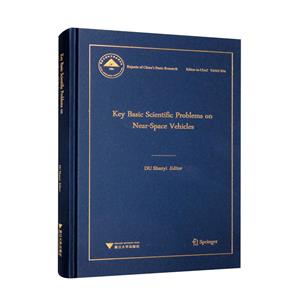-
>
公路車寶典(ZINN的公路車維修與保養秘籍)
-
>
晶體管電路設計(下)
-
>
基于個性化設計策略的智能交通系統關鍵技術
-
>
花樣百出:貴州少數民族圖案填色
-
>
山東教育出版社有限公司技術轉移與技術創新歷史叢書中國高等技術教育的蘇化(1949—1961)以北京地區為中心
-
>
鐵路機車概要.交流傳動內燃.電力機車
-
>
利維坦的道德困境:早期現代政治哲學的問題與脈絡
Key basic scientific problems on near-space vehicles 版權信息
- ISBN:9787308227612
- 條形碼:9787308227612 ; 978-7-308-22761-2
- 裝幀:一般膠版紙
- 冊數:暫無
- 重量:暫無
- 所屬分類:>
Key basic scientific problems on near-space vehicles 內容簡介
As Lao Tzu said,"A huge tree grows from a tiny seedling a nine-storied tower rises from a heap of earth." Basic research is the fundamental approach to fostering innovation-driven development,and its level becomes an important yardstick for measuring the overall scientific and national strength of a country. Since the beginning of the 21st century,China's overall strength in basic research has been consistently increasing. With respect to input and output,China's input in basic research increased by 14.8 times from 5.22 billion yuan in 2001 to 82.29 billion yuan in 2016,with an average annual increase of 20.2%. In the same period,the number of China's scientific papers included in the Science Citation Index (SCI)increased from lower than 40,000 to 324,000;China rose from the 6th to the 2nd place in global ranking in terms of the number ofpublished papers. In regard to the quality of output,in 2016,China ranked No. 2 in the world in terms of citations in 9 disciplines,among which the materials science ranked No. 1;as of October 2017,China ranked No. 3 in the world in the numbers of both Highly Cited Papers (top 1%) and Hot Papers (top 0.1%),with the latter accounting for 25.1% of the global total. In talent cultivation,in 2006,China had 175 scientists (136 ofwhom from the Chinese mainland) included in Thomson Reuters' list of Highly Cited Researchers,ranking 4th globally and lst in Asia.Meanwhile,we should also be keenly aware that China's basic research is still facing great challenges. First,funding for basic research in China is still far less than that in developed countries-only about 5% of the R&D funds in China are used for basic research,a much lower percentage than 15%-20% in developed countries. Second,competence for original innovation in China is insufficient.Major original scientific achievements that have global impact are still rare. Most of the scientific research projects are just a follow-up or imitation of existing research,rather than groundbreaking research. Third,the development of disciplines is not balanced,and China's research level in some disciplines is noticeably lower than the international level-China's Field-Weighted Citation Impact (FWCI) in disciplines just reached 0.94 in 2016,lower than the world average of 1.0.Lao Tzu said, "A huge tree grows from a tiny seedling; a nine-storied tower rises from a heap of earth." Basic research is the fundamental approach to fostering innovation-driven development, and its level becomes an important yardstick for measuring the overall scientific and national strength of a country. Since the beginning of the 21st century, China's overall strength in basic research has been consistently increasing. With respect to input and output, China's input in basic research increased by 14.8 times from 5.22 billion yuan in 2001 to 82.29 billion yuan in 2016, with an average annual increase of 20.2%. In the same period, the number of China's scientific papers included in the Science Citation Index (SCI)increased from lower than 40,000 to 324,000; China rose from the 6th to the 2nd place in global ranking in terms of the number ofpublished papers. In regard to the quality of output, in 2016, China ranked No. 2 in the world in terms of citations in 9 disciplines, among which the materials science ranked No. 1; as of October 2017,China ranked No. 3 in the world in the numbers of both Highly Cited Papers (top 1%) and Hot Papers (top 0.1%), with the latter accounting for 25.1% of the global total. In talent cultivation, in 2006, China had 175 scientists (136 ofwhom from the Chinese mainland) included in Thomson Reuters' list of Highly Cited Researchers,ranking 4th globally and lst in Asia.Meanwhile, we should also be keenly aware that China's basic research is still facing great challenges. First, funding for basic research in China is still far less than that in developed countries-only about 5% of the R&D funds in China are used for basic research, a much lower percentage than 15%-20% in developed countries. Second, competence for original innovation in China is insufficient.Major original scientific achievements that have global impact are still rare. Most of the scientific research projects are just a follow-up or imitation of existing research,rather than groundbreaking research. Third, the development of disciplines is not balanced, and China's research level in some disciplines is noticeably lower than the international level-China's Field-Weighted Citation Impact (FWCI) in disciplines just reached 0.94 in 2016, lower than the world average of 1.0.
Key basic scientific problems on near-space vehicles 作者簡介
近空間飛行器的關鍵基礎科學問題項目組,項目組組長為杜善義。中國工程院院士,力學和復合材料專家。長期從事飛行器結構力學和復合材料的教學及科研工作。
- >
我與地壇
- >
羅庸西南聯大授課錄
- >
名家帶你讀魯迅:故事新編
- >
姑媽的寶刀
- >
李白與唐代文化
- >
小考拉的故事-套裝共3冊
- >
人文閱讀與收藏·良友文學叢書:一天的工作
- >
羅曼·羅蘭讀書隨筆-精裝
















